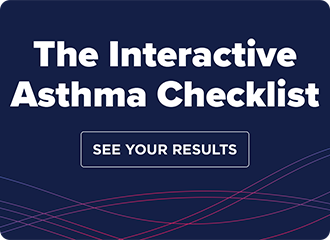

UNDERSTANDING SEVERE ASTHMA
TIPS & RESOURCES
Meet Dr. Maureen George, the behavioral scientist who helped develop a simple, but powerful description of severe asthma and checklist that are helping people understand and talk about their disease.
All too often, living with and accepting the symptoms of severe asthma becomes the norm for people with the disease, so much that they may not even realize their asthma is severe.1 Eventually there comes a tipping point – an experience or a moment that makes people realize their symptoms are out of hand, such as missing an important family event – that acts as a trigger to demand a greater level of control. We had the opportunity to speak with Dr. George, a behavioral scientist, nurse and certified asthma educator from the Columbia University School of Nursing, about the mindset of people living with a chronic disease like severe asthma and how they might shift their perspective about their disease.
Drawing on her recent experiences in clinical care, Dr. George shared, “People have to see themselves at risk, have to see that the benefits of treatment outweigh the challenges of the disease, and that the goal of treatment will give them something that they desire.”
When severe asthma patients visited her clinic for a consultation, Dr. George walked them through what she called her “worry index,” which were the goals of asthma management in patient-friendly terms. She helped patients talk about those worries and understand when multiple symptoms indicated their asthma was uncontrolled and severe. She then reassured them that severe asthma is controllable and manageable. “I saw patients light up at that kind of tailored feedback.”
From Severe Asthma to Better Asthma Control
Dr. George’s learnings from her “worry index” would prove helpful. In 2018, she joined a multidisciplinary working group aimed at helping people better understand what severe asthma is and prompt those struggling with control to become concerned enough to visit their healthcare professional.2 The following year, the Patient Understanding Leading to Assessment for a Severe Asthma Referral (PULSAR) initiative published a patient-centered description of severe asthma and a checklist with signs and symptoms to be aware of.
Knowing that patients and providers may have different definitions of asthma control,3 Dr. George knew that first and foremost, the PULSAR definition and checklist had to be patient-centered and practical for everyone.
“When I thought about the definition, I wanted it to really speak to both perspectives – the patient and the clinician – and to be in a language that made sense to anyone with any educational or cultural demographic background.”
Dr. George was able to take what she had learned from her experience as an advanced practice nurse and a behavioral scientist to help shape the PULSAR definition and checklist into a tool that helps improve discussions, which may otherwise be confusing, between patients and doctors.
Following Dr. George’s input, the final definition and checklist were reviewed by people living with severe asthma. Most patients reported that they understood the PULSAR description and checklist and it would encourage them to see their primary care physician about their asthma.2
You can learn more about the PULSAR initiative and the development of the severe asthma description and checklist by reading this article. We also encourage you to explore The Next Breath to find out about severe asthma and get connected to tools to help you start a conversation about better asthma control.
References
- 1. Partridge MR, et al. Attitudes and actions of asthma patients on regular maintenance therapy: the INSPIRE study. BMC Pulm Med. 2006;6:13.
- 2. Winders TA, Wilson AM, Fletcher MJ, et al. A Patient‑Centered Description of Severe Asthma: Patient Understanding Leading to Assessment for a Severe Asthma Referral (PULSAR). Patient. 2019. https://doi.org/10.1007/s40271-019-00371-0.
- 3. Price et al. Asthma control and management in 8,000 European patients: the Recognise Asthma and Link to Symptom and Experience (REALISE) survey. NPJ Prim Care Respir Med. 2014. 12(24):14009.
Date of Approval: January 2020 | SAGLB.AST.20.01.0027



Join the Next Breath Challenge: It’s Time to Prioritize Asthma Control & Demand Access to Specialized Care
The Next Breath Editorial Team
5/4/2021 12:00:00 AM
The Next Breath Challenge encourages you to gently blow out a digital candle, creating a powerful symbol for prioritizing better asthma control. Take action now.

3 Things To Know About Frequent Oral Corticosteroid Use
The Next Breath Editorial Team
3/22/2021 12:00:00 AM
Learn more about oral corticosteroids, including their use as an asthma medicine and when to talk with a doctor about ways to achieve better asthma control.

Join the Next Breath Challenge: It’s Time to Prioritize Asthma Control & Demand Access to Specialized Care
The Next Breath Editorial Team
5/4/2021 12:00:00 AM
The Next Breath Challenge encourages you to gently blow out a digital candle, creating a powerful symbol for prioritizing better asthma control. Take action now.

3 Things To Know About Frequent Oral Corticosteroid Use
The Next Breath Editorial Team
3/22/2021 12:00:00 AM
Learn more about oral corticosteroids, including their use as an asthma medicine and when to talk with a doctor about ways to achieve better asthma control.
Moving the future of asthma forward, together
Working together, we can
bring more awareness to severe
asthma,
illuminate
the latest science and
empower people to take action
to strive for
better asthma control.
Start
using your next breath today to inspire others
to get informed and
check back
soon to find more ways to get involved.
































